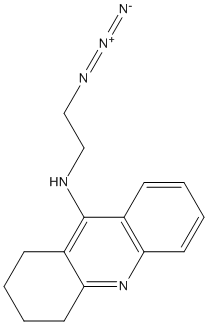Tz2
AChE Active site inhibitor (tacrine) equipped with an azide group at the end of a methylene chain used as building block of 1,3-dipolar cycloaddition (click chemistry) with a PAS inhibitor (phenylphenanthridinium) equipped with an acatylene group at the end of a flexible methylene chain
General
Type : Acridine,Derivative of Tacrine,Azido
Chemical_Nomenclature : N-(2-azidoethyl)-1,2,3,4-tetrahydroacridin-9-amine
Canonical SMILES : C1CCC2=NC3=CC=CC=C3C(=C2C1)NCCN=[N+]=[N-]
InChI : InChI=1S\/C15H17N5\/c16-20-18-10-9-17-15-11-5-1-3-7-13(11)19-14-8-4-2-6-12(14)15\/h1,3,5,7H,2,4,6,8-10H2,(H,17,19)
InChIKey : ANJRGTMSMVLPLB-UHFFFAOYSA-N
Other name(s) : 1-Azido-ethyl-2-amino-N'-9'-(1',2',3'4,'-tetrahydroacridinyl) hydrochloride
MW : 267.33
Formula : C15H17N5
CAS_number :
PubChem : 86032728
UniChem : ANJRGTMSMVLPLB-UHFFFAOYSA-N
IUPHAR :
Wikipedia :

Target
References (4)
| Title : Steric and Dynamic Parameters Influencing In Situ Cycloadditions to Form Triazole Inhibitors with Crystalline Acetylcholinesterase - Bourne_2016_J.Am.Chem.Soc_138_1611 |
| Author(s) : Bourne Y , Sharpless KB , Taylor P , Marchot P |
| Ref : Journal of the American Chemical Society , 138 :1611 , 2016 |
| Abstract : Bourne_2016_J.Am.Chem.Soc_138_1611 |
| ESTHER : Bourne_2016_J.Am.Chem.Soc_138_1611 |
| PubMedSearch : Bourne_2016_J.Am.Chem.Soc_138_1611 |
| PubMedID: 26731630 |
| Gene_locus related to this paper: mouse-ACHE |
| Title : Freeze-frame inhibitor captures acetylcholinesterase in a unique conformation - Bourne_2004_Proc.Natl.Acad.Sci.U.S.A_101_1449 |
| Author(s) : Bourne Y , Kolb HC , Radic Z , Sharpless KB , Taylor P , Marchot P |
| Ref : Proc Natl Acad Sci U S A , 101 :1449 , 2004 |
| Abstract : Bourne_2004_Proc.Natl.Acad.Sci.U.S.A_101_1449 |
| ESTHER : Bourne_2004_Proc.Natl.Acad.Sci.U.S.A_101_1449 |
| PubMedSearch : Bourne_2004_Proc.Natl.Acad.Sci.U.S.A_101_1449 |
| PubMedID: 14757816 |
| Gene_locus related to this paper: mouse-ACHE |
| Title : Cover picture: angew. Chem. Int. Ed. 6\/2002 - Lewis_2002_Angew.Chem.Int.Ed.Engl_41_875 |
| Author(s) : Lewis WG , Green LG , Grynszpan F , Radic Z , Carlier PR , Taylor P , Finn MG , Sharpless KB |
| Ref : Angew Chem Int Ed Engl , 41 :875 , 2002 |
| Abstract : Lewis_2002_Angew.Chem.Int.Ed.Engl_41_875 |
| ESTHER : Lewis_2002_Angew.Chem.Int.Ed.Engl_41_875 |
| PubMedSearch : Lewis_2002_Angew.Chem.Int.Ed.Engl_41_875 |
| PubMedID: |
| Title : Click chemistry in situ: acetylcholinesterase as a reaction vessel for the selective assembly of a femtomolar inhibitor from an array of building blocks - |
| Author(s) : Lewis WG , Green LG , Grynszpan F , Radic Z , Carlier PR , Taylor P , Finn MG , Sharpless KB |
| Ref : Angew Chem Int Ed Engl , 41 :1053 , 2002 |
| PubMedID: 12491310 |